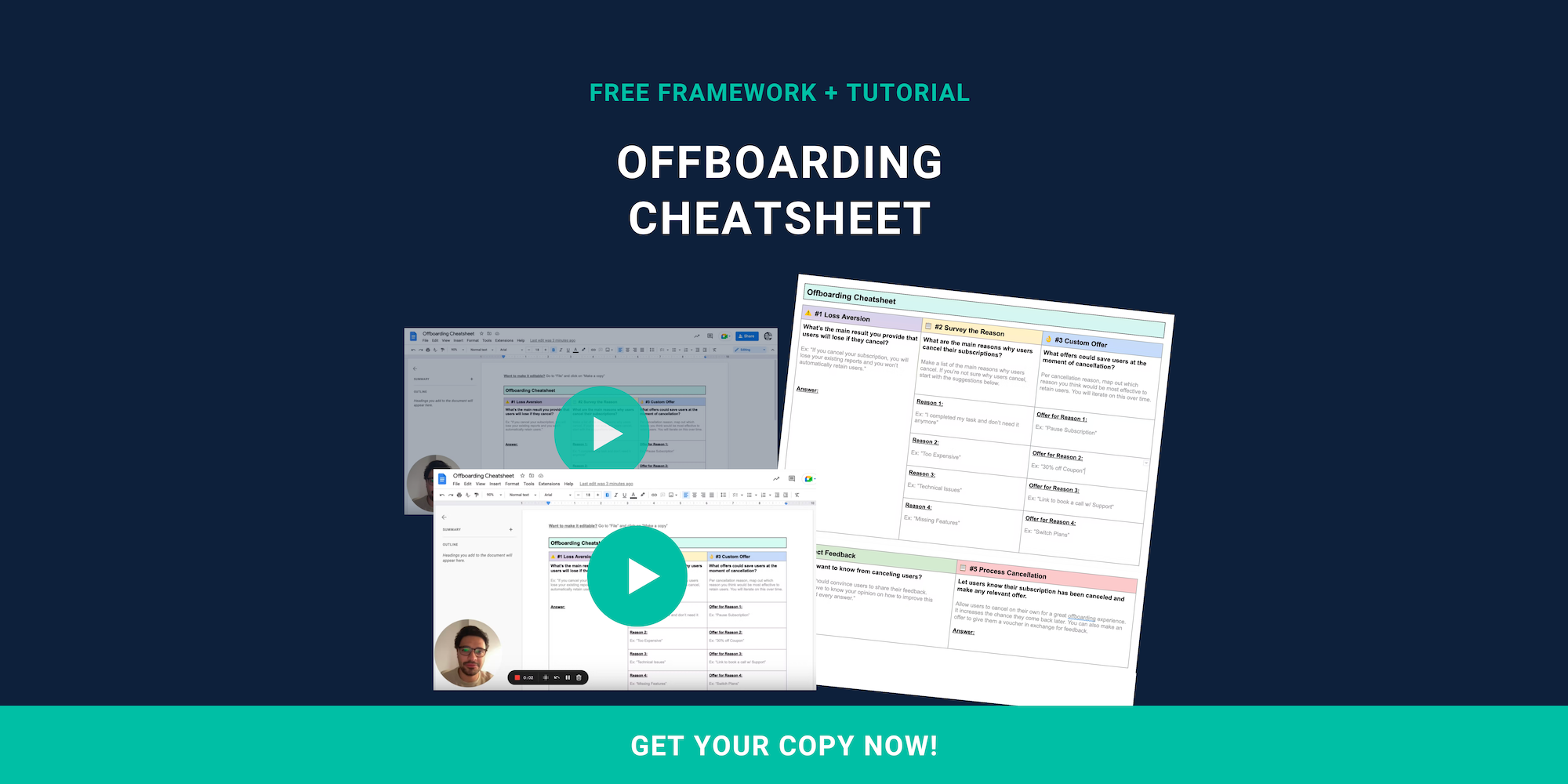Table of Contents
- 10 Tactics For Customer Retention And Churn Management
- 1 - Prioritize Onboarding: Turn New Users Into Power Users
- 2 - Deliver Value Early: Get Users To The "Aha!" Moment Fast
- 3 - Continuously Improve: Never Stop Evolving Your Product
- 4 - Proactive Customer Success: Anticipate Needs & Exceed Expectations
- 5 - Gather Feedback Everywhere: Make Your Voice Heard
- 6 - Personalization Is King: Treat Every Customer Like A VIP
- 7 - Address Churn At The Root: Don't Let Them Slip Away Silently
- 8 - Embrace Cancellation Flows: Leverage Powerful Tools Like Raaft
- 9 - Track The Right Metrics: Focus On What Matters Most
- 10 - Make It Effortless To Stay: Frictionless Interactions Are Key
- Closing Thoughts On Customer Retention And Churn Management
In my experience building and scaling SaaS businesses, customer churn is a constant battle. You fight hard to acquire users, but if you don't keep them engaged and satisfied, they'll simply slip away. For me, churn isn't an inevitability, it's a manageable challenge. Here are 10 tactics I've found effective in reducing churn and keeping customers happy, along with some additional insights to put them into action:
10 Tactics For Customer Retention And Churn Management
1 - Prioritize Onboarding: Turn New Users Into Power Users
When I'm first onboarding a new customer, I make sure they get the most out of the product quickly. A smooth onboarding process with clear instructions and helpful resources sets the stage for long-term success. Here's how to take it a step further:
Personalize the onboarding experience
Tailor the onboarding journey based on the user's specific needs and goals. This could involve different onboarding flows for different user segments or offering tiered onboarding options for new users versus experienced professionals.
Utilize interactive elements
Don't just tell users what to do, show them! Incorporate interactive walkthroughs, tooltips, and explainer videos to make the onboarding process more engaging and memorable.
Measure onboarding success
Track key metrics like time to value and feature adoption to identify areas for improvement in your onboarding process.
2 - Deliver Value Early: Get Users To The "Aha!" Moment Fast
I always focus on getting customers to the "aha!" moment as fast as possible. This is the point where they see the true value of your product and understand how it solves their problems. Here are some ways to expedite this process:
Identify the most impactful features
Pinpoint the features that deliver the most immediate value to your target users. Prioritize these features in your onboarding process and product tours.
Showcase customer success stories
Highlight how other customers have achieved success using your product. This can inspire new users and give them a roadmap for their own success.
Offer in-app guidance
Provide contextual help within the product itself. This could be through hover-over explanations, interactive tutorials, or even chatbots that answer user questions in real-time.
3 - Continuously Improve: Never Stop Evolving Your Product
In my opinion, a stagnant product is a recipe for churn. I recommend gathering customer feedback regularly and using it to inform product development. This ensures your product stays relevant and addresses evolving customer needs. Here are some ways to make this a continuous process:
Establish feedback loops
Create multiple channels for customers to share their feedback, such as in-app surveys, email campaigns, and user interviews.
Prioritize user pain points
Analyze customer feedback to identify the most common pain points and frustrations. Focus your development efforts on addressing these issues first.
Embrace a data-driven approach
Don't just rely on gut feeling. Use user data and analytics to measure the impact of your product changes and see what resonates with your customers.
4 - Proactive Customer Success: Anticipate Needs & Exceed Expectations
I don't wait for customers to reach out with issues. I try to anticipate their needs and proactively offer support. This could involve regular check-ins, personalized usage tips, or targeted educational content. Here are some ways to take a proactive approach to customer success:
Segment your customer base
Group your customers based on their usage patterns, industry, or company size. This allows you to tailor your outreach efforts and provide more relevant support.
Utilize customer success automation tools
There are a number of tools available that can help you automate tasks such as sending onboarding emails, scheduling check-ins, and triggering alerts for at-risk customers.
Invest in your customer success team
Empower your customer success team with the resources and training they need to provide exceptional support. This includes in-depth product knowledge, communication skills, and the ability to build strong relationships with customers.
5 - Gather Feedback Everywhere: Make Your Voice Heard
I like to sprinkle feedback mechanisms throughout the user journey. This could be surveys, in-app prompts, or even live chat options. The key is to make it easy for customers to share their thoughts and concerns. Here are some additional ways to encourage customer feedback:
Net Promoter Score (NPS) surveys
Regularly send out NPS surveys to measure customer loyalty and satisfaction.
In-product feedback buttons
Place strategically placed feedback buttons throughout your product to allow users to provide immediate feedback on their experience.
Host user feedback sessions
Conduct regular user interviews or focus groups to gain deeper insights into customer needs and challenges.
6 - Personalization Is King: Treat Every Customer Like A VIP
Whenever I can, I personalize the customer experience. This could be through targeted communication, recommending relevant features, or offering custom plans. A little personalization goes a long way in making customers feel valued. Here are some ways to personalize the SaaS experience:
Recommend features based on usage
Analyze user data to identify features that are relevant to a particular user's needs and behavior. Then, proactively recommend these features through in-app notifications or personalized emails.
Offer targeted educational content
Create content that addresses the specific challenges and goals of different customer segments. This could be blog posts, webinars, or even case studies that showcase how similar customers have achieved success.
Utilize dynamic pricing
Consider offering tiered pricing plans or custom quotes that cater to the specific needs and budget of each customer. This demonstrates flexibility and makes your product more accessible to a wider range of users.
7 - Address Churn At The Root: Don't Let Them Slip Away Silently
When a customer cancels, I don't just accept it. I dig deeper to understand the reason behind their decision. This could be through exit surveys, win-back campaigns, or even talking to them directly. Here are some ways to gain valuable insights from customer churn:
Exit interview calls
Schedule calls with customers who are canceling their subscription to understand their specific reasons for leaving. This can help you identify areas for improvement in your product or service.
Analyze exit survey data
Use exit surveys to gather quantitative data on why customers are churning. This data can be used to identify trends and common pain points.
Offer win-back campaigns
Don't give up on lost customers entirely. Consider running targeted win-back campaigns with special offers or incentives to entice them to come back.
8 - Embrace Cancellation Flows: Leverage Powerful Tools Like Raaft

For me, cancellation flows are a powerful tool. Raaft, for example, lets you build custom cancellation flows that gather feedback and offer incentives to keep users on board. They can also provide valuable insights into why customers churn. Here's why cancellation flows are essential and how Raaft can help:
Gather valuable feedback at the point of churn
Cancellation flows allow you to capture customer feedback in the moment when they're considering leaving. This feedback is often more honest and actionable than feedback collected through other channels.
Offer targeted incentives to prevent churn
With Raaft, you can create cancellation flows that offer incentives such as discounts, downgrades, or even free consultations to entice customers to stay.
Gain insights to improve your product
By analyzing the data collected through cancellation flows, you can identify common reasons for churn and make data-driven decisions to improve your product and user experience.
Raaft simplifies the process of creating and managing cancellation flows, saving your development team valuable time and resources. It also empowers your customer success team to personalize the cancellation experience and potentially salvage at-risk customers.
9 - Track The Right Metrics: Focus On What Matters Most
I don't manage what I don't measure. That's why I closely track key customer health metrics like churn rate, customer lifetime value (CLTV), and Net Promoter Score (NPS). These metrics help me identify areas for improvement and measure the effectiveness of my retention efforts. Here are some additional metrics to consider tracking:
Customer Satisfaction Score (CSAT)
This metric measures customer satisfaction with a specific interaction, such as onboarding or customer support experience.
Time to Value (TTV)
This metric measures the time it takes for a customer to realize the value of your product.
Feature Adoption Rate
This metric tracks how many users are actively using specific features of your product. By tracking these metrics, you can gain a holistic view of your customer health and identify areas where you can improve the customer experience.
10 - Make It Effortless To Stay: Frictionless Interactions Are Key
From my perspective, every interaction a customer has with your business should be effortless. This includes a seamless billing experience, easy access to support, and clear communication about plans and pricing. Here are some ways to make it easy for customers to stay with you:
Offer flexible billing options
Provide a variety of payment methods and allow customers to easily update their billing information. Consider offering annual subscriptions at a discount to incentivize long-term commitment.
Empower your customer support team
Ensure your customer support team is well-equipped to handle customer inquiries promptly and efficiently. Offer multiple support channels, such as email, live chat, and phone support.
Communicate clearly and transparently
Be upfront about your pricing, terms of service, and any limitations of your product. Avoid hidden fees and unexpected charges. Regularly communicate product updates, feature changes, and important announcements to keep your customers informed.
Closing Thoughts On Customer Retention And Churn Management
By implementing these 10 tactics and focusing on creating a seamless and valuable customer experience, you can significantly reduce customer churn and build a loyal customer base. Remember, a happy customer is a recurring customer, and recurring customers are the lifeblood of any SaaS business. Here are some additional thoughts on keeping your customers happy:
Build a community
Foster a sense of community among your users by creating online forums, user groups, or even hosting industry events. This can help your customers connect with each other, share best practices, and feel more invested in your product.
Recognize and reward loyal customers
Show your appreciation for your most loyal customers through exclusive discounts, early access to new features, or even personalized gifts.
Invest in customer success from the beginning
Don't wait until customers are at risk of churning to invest in customer success. Make customer success a core part of your business strategy from day one.
By following these tips and continuously iterating on your customer retention efforts, you can turn churn into a distant memory and build a thriving SaaS business.
To boost customer retention and churn management, why not create some cancellation flows with Raaft? This is a must-have tool for building robust cancellation flows to prevent user churn. Try Raaft for free.
Each SaaS founder has unique needs and budget considerations when choosing a retention tool. While ProfitWell Retain can be suitable for certain businesses, others may find more value in alternatives offering advanced features at a more competitive price. Therefore, it's crucial to explore all available options to find the perfect fit for your SaaS business.
You may also like:
User Behavior Analytics (Reduce SaaS Churn)
Collecting Customer Feedback (Best SaaS User Feedback Software)

Offboarding Cheatsheet
This framework + video tutorial will help you design a better cancellation process.
Some of our featured articles

Adam Crookes

Miguel Marques
Customer Success insights in your inbox
Helping Founders and Customer Success Managers handle customer retention effectively.
We will only ever send you relevant content. Unsubscribe anytime.

